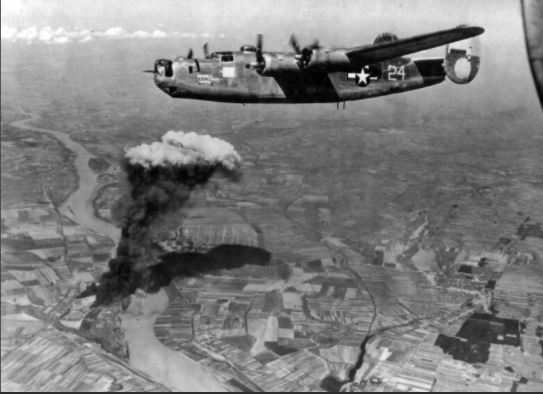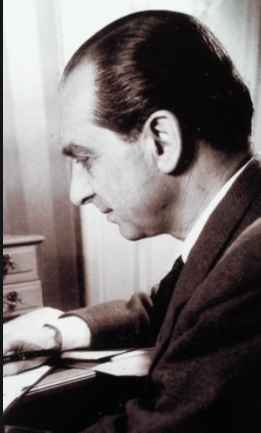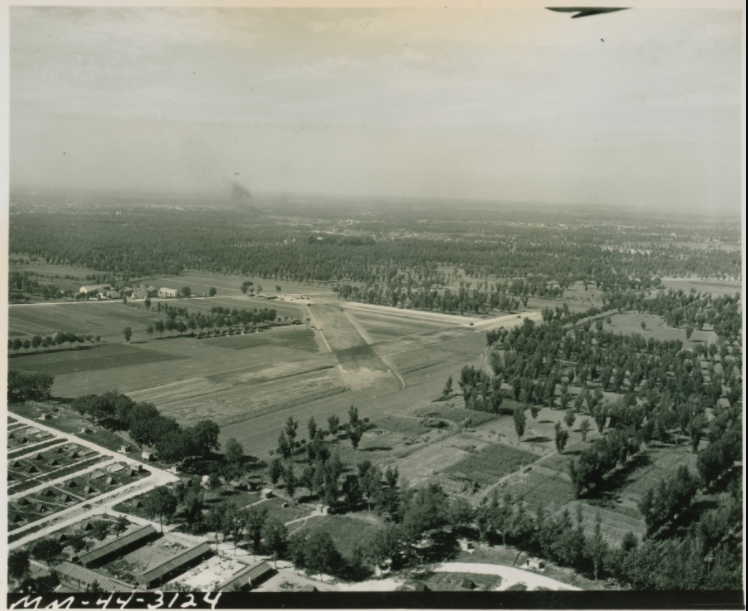
Hungarian Attempts to Change Sides
In March 1942 Horthy appointed Miklós Kállay to prime minister with the task to regain the space of manouvering in foreign diplomacy for the country and to preserve the integrity of its military forces in such an extent that whoever wins the the country should be still able to fight for and reoccupy its territories lost by the Treaty of Trianon. However in the winter of 1941/1942 many Hungarian politicians already doubted that Germany will overcome its opponents and win the war, the Hungarian government began to actively seek for contacts and start preliminary ceasefire negotiations with the Western Allies only after the disastrous defeat of the 2nd Hungarian Army at the River Don in January 1943.
During the night of 9th-10th September 1943 Laszlo Veress (secretary of the Hungarian Foreign Ministry) signed a preliminary ceasefire agreement , in accordance with which Hungary would have unconditionally surrender if allied forces had arrived at the Hungarian border. The country would have cut back military and economic support to Germany and resist any attempt by Germany to occupy.
On 28th August 1944 Miklós Horthy
On August 28, 1944, Miklós Horthy commissioned György Bakách-Bessenyei, the former ambassador in Bern , to contact the Anglo-Saxons again. They were already referring to the Soviets by this time.

On the 23rd August Romania changed sides in the war putting Hungary into an awkward situation with the Soviet army already on its eastern borders. Because of its sympathy to Nazi Germany the Regent decided immediately to dismiss the Sztójay government and appointed a new cabinet under the leadership of Major General Géza Lakatos on that day with the task of leading the country out from the war. But the new government feared taking this step against the Reich and refused to vote for a peace agreement with the Allies. Despite this setback, on the 7th September Horthy convened a meeting of the Crown Council and ordered the government to start peace negotiations. Horthy, perhaps mistakenly believing the military were most loyal to his leadership, didn’t risk challenging the Germans with a further change in government and Prime Minister Lakatos and his ministers remained in office. [1]
That same day Major General Náday and the American General Charles Howie were sent to Caserta, the headquarters of the Western Allies in Italy, bearing the unconditional surrender of the Hungarian government. However, as the Letter of Authority was unsigned and didn’t carry his name, he was simply treated as a surrendering enemy officer. Furthermore, the code he used in telegrams sent to the Hungarian Royal Palace could not be deciphered and his urgent messages remained unanswered. [2]

We know that the three powers [3] had already agreed, a year before in Casablanca, on their participation in the occupation of Europe, and it was clear from January of 1943 that the two western powers would never enter central European territory, however it served their interests to reassure central European politicians. Josef Bros Tito. [4]
in Caserta in 1944, was told that a landing in the Balkans was under consideration - leaders of the central European nations would clearly have preferred a Western Allied occupation to a Soviet. When this misleading communication led the Hungarians to contact the Western Allies in Caserta, however, they were told directly that Hungary should turn to Moscow with a peace initiative as Soviet troops had already crossed her borders. Tito realized that with Romania’s shift in allegiance the Soviet troops were already at the border of the former Yugoslavia. He left Caserta, vanished from the Western Allies’ sight and appeared in Moscow in the first days of September. [5]
A few days after the failure of the Regent’s envoy to Caserta, a letter of invitation purporting to have been written by a Soviet General by the name of Makarov was handed to ‘General Sztojanovics’, Hungary’s representative, calling for negotiations between the two countries and offering extraordinarily acquiescent conditions. This was most likely a communication between the Soviet and Hungarian military secret services. Partly as a result of Makarov/Sztoyanovics correspondence, at the end of September 1944, Hungary reluctantly accepted that it had no choice but to turn to the Soviets and a secret delegation, disguised as a group of hunters, crossed the Hungarian/Soviet border under the leadership of Major General Gábor Faragho. They were carrying a handwritten letter of authorisation from Horthy. [6]
The Soviet side, namely Foreign Minister Molotov, denied the validity of the Makarov letter and handed the delegation the official proposal for unconditional surrender, which also required Hungary’s military co-operation with the Soviet army. At first this proposal was unacceptable to Horthy who turned it down, two days later however he confirmed his consent. It was signed on the 11th October by Faragho. The conditions had to be met by the 20th October. However, the Kremlin seeing that no preparations were being made brought date forward to the 16th. [7]

When the German secret service learned of these meetings one of its agents was instructed to infiltrate the Yugoslavian partisan delegation in Budapest. Meanwhile, an SS commando unit, under the leadership of Otto Skorzeny, arrived in Budapest tasked with occupying the Royal Palace in the event of any Hungarian attempt to declare a ceasefire. On the 15th October, the secret service agent enticed Miklós Horthy out of the palace with news of a letter from General Tito. The Skorzeny commandoes surrounded the meeting place, broke in and kidnapped the son of the Regent taking him to Mauthausen, a concentration camp on the outskirts of Vienna. [8]
As the deadline for the ceasefire declaration had been brought forward, his father had intended to make the declaration that day, however, a cataclysmic series of events was set in train that morning. [9]
News was received of his son’s abduction, as a result of which a scheduled meeting of the government was postponed for half an hour. The day before, Prime Minister Lakatos and the head of the Regent’s cabinet, Count Gyula Ambrózy, had agreed to delete the most important line - ‘from this point forward Hungary considers itself at war with Germany’ - from the text of the Regent’s communiqué. Without Horthy’s consent to this Ambrózy did not, as planned, read the text over the phone for broadcast at the end of the government meeting where Horthy would be informing Veesenmeyer of the ceasefire. When he finally had the opportunity to talk to Horthy, the Regent, impatient at the delay, immediately sent him to broadcast the text without giving him the opportunity to seek his permission, so this crucial sentence was not included in the communiqué. The detailed military orders did not arrive with the capital’s defence forces as the Commander of the city was arrested by his subordinate, using his own gun which had been left in his uniform jacket on the back of his door that morning .
Nor did army units fighting on the frontline receive any order as the Hungarian general staff refused to forward the Regent’s military orders. In the early afternoon the Hungarian Arrow Cross party seized Rádio and the main strategic points of the capital. At 3pm, in the name of János Vörös, a communiqué was broadcast which declared that the somewhat ambiguous proclamation of the Regent simply meant that there were ongoing peace negotiations and the fight must be carried on at the frontline. By the end of the day the Regent could rely only on the Palace guard, officially only responsible for his own and his family’s safety.
Preparing for a possible German attack, late that afternoon, a circle of mines had been laid around the “Várnegyed,” the district of Budapest where the Palace and the German embassy were located. Veesenmayer - in the German embassy and realising he had effectively become a hostage - called the palace guard and ordered them to open this defence line.
The head of the unit, Károly Lázár, although known for his loyalty to the Regent, obeyed, probably to avoid senseless loss of life and to protect the Regent and not fully understanding that Veesenmeyer could otherwise be held hostage. During that night Ambrozy, leader of the Regent’s cabinet and Lieutenant Colonel Antal Vattay, head of the Regent’s military office, visited Horthy and requested he put himself under German ‘protection’. Horthy categorically refused. However, Ambrozy reported that Horthy had called for German protection for himself and his family. Veesenmayer informed the Führer who gave his consent.
At around 6am on the 16th October the Skorzeny SS Unit acting on their orders to take the palace in the event of a ceasefire proclamation, attacked and, after a brief battle with the Guard occupied it. Veesenmayer, arriving with him at the Royal Palace asked the Regent to go with him to the Hatvany Palace - the German embassy - where, he would be under the ‘protection’ of the Führer and avoid the discomfort of witnessing the occupation of the Palace. [10]
During that day, the Regent twice refused to appoint Ferenc Szálasi, leader of the Arrow Cross Party, Prime Minister and signed a communiqué about his resignation only when Prime Minister Géza Lakatos informed him that his son’s life depended on it. [11]
On 17th October the Regent, together with his wife, grandson, daughter-in-law and his closest family employees were taken into custody and transported to Germany where they were held as prisoners of war by the SS in the castle of Count Hirschberg in Upper Bavaria. They were cut off from all news of the war until January 1945 when the newly arrived, younger brother of the Regent managed to smuggle a radio into the castle. Using this the family could secretly listen to allied broadcasts [12]
On the 1st May 1945 soldiers of the 7th US Army were the first to arrive in the area of Weilheim and Schloss Hirschberg. The SS unit had left a few days earlier. On this day Miklós Horthy’s American custody began, at first he was taken to a mansion on the outskirts of Augsburg where his first interrogations were recorded. It was here, on the 9th May, that he was informed that his son Miklós was alive and had been found by the American army. The former Regent was transferred to a prisoner of war camp in Belgium where former members of the Hungarian Arrow Cross leadership were also held. This was where he was first informed of the apocalyptic siege of Budapest a few months earlier in the winter of 1944-45 . During that year he was held at several POW camps: Lesbois, Mondorf, Wiesbaden, Oberursel and Nuremberg.Joseph Stalin was, from the beginning, against the request of the new Hungarian government to arrest Horthy as a war criminal and give him up to the Hungarian authorities. As far as he was concerned his decision was purely political.
The period 1920-1944 is identified with the name of Horthy, the official press echoed with his name, the name of a national hero. If he had been tried, sentenced and executed at least a part of Hungary would have regarded him as a martyr and this was the last thing the Soviet leader would want in a country occupied by the Red Army.The first interrogation was held on the 27th August 1945, he was asked about Hungary’s war declarations, the details of its participation in Germany’s operations, the peace negotiations and the anti-Jewish legislation in Hungary. A month later, on the 27th September, the former Regent was transferred to Nuremberg together with other notable prisoners of war [Franz von Papen, the former German Ambassador in Turkey, among others], where he was no longer treated as a war criminal but as a witness. Here he was asked primarily about his negotiations with Hitler.On the 1st December 1945 he was allowed to meet his son whom he hadn’t seen for more than a year and after this was allowed to see him regularly. On the 17th December he was released.

References
Photos:
1.) Georg-Bakach-Bessenyei source: find a grave
https://www.findagrave.com/memorial/84392944/gyorgy-bakach-bessenyey
2.) Aerial view of the allied forces headquarters in Caserta. source:https://www.ww2online.org/image/aerial-view-allied-forces-headquarters-air-field-caserta-italy-9-september-1944-1
3.) General Gábor Faragho
source: http://www.bibl.u-szeged.hu/bibl/mil/ww2/who/faragho.html
4.) Schloss Hirschberg am Haarsee
source: Jahrbuch Lech-Isar-Land, ed. Bernard Völl, Thomas Dorsch, Klaus Glast, 2011. titel page
[1] Vígh Károly: Ugrás a sötétbe, Budapest, 1984. 73.
[2] Vígh Károly: Ugrás a sötétbe, Budapest, 1984. 73.
[3] Great Britain, the United States and the Soviet Union
[4] Leader of the anti-fascist partisans in German occupied Yugoslavian territories
[5] Par Walter, R. Roberts: Tito, Mihailović and the Allies 1941 – 1945 Durham 1987, 261.
[6] Bárdossy László a népbíróság előtt, szerkesztette:Pritz Pál, 1991.39.
[7] Edelsheim-Gyulai 2008, I. 289.
[8] Bern, Andrea: A “Mickey Mouse Hadművelet” Háttere in: Napi Történelmi Forrás, 13.12.2016 Gárdos Miklós: A bélyeges sereg, Budapest 1990, 236
[9] Ungváry Krisztián: A magyar honvédség a második világháborúban, Budapest, 2005.234.
[10] Horthy Miklós: Emlékirataim, Budapest, 1990.310
Bern Andrea: “Mától fogva Magyarország hadiállapotban levőnek tekinti magát Németországgal” – egy soha el nem hangzott mondat története in: Napi Történelmi Forrás: 19/03/2017.
http://Ntf.Hu/Index.Php/2017/03/19/Matol-Fogva-Magyarorszag-Hadiallapotban-Levonek-Tekinti-Magat-Nemetorszaggal-Egy-Soha-El-Nem-Hangzott-Mondat-Tortenete/#_Ednref8
Utolsó megnyitás: 15/05/2017.
[11] Ibid.314..
[12] Horthy Miklósné: Napló, 1944-1945..
Szerkesztette: Bern Andrea, Budapest, 2015.42-43.Horthy 1990, 338.